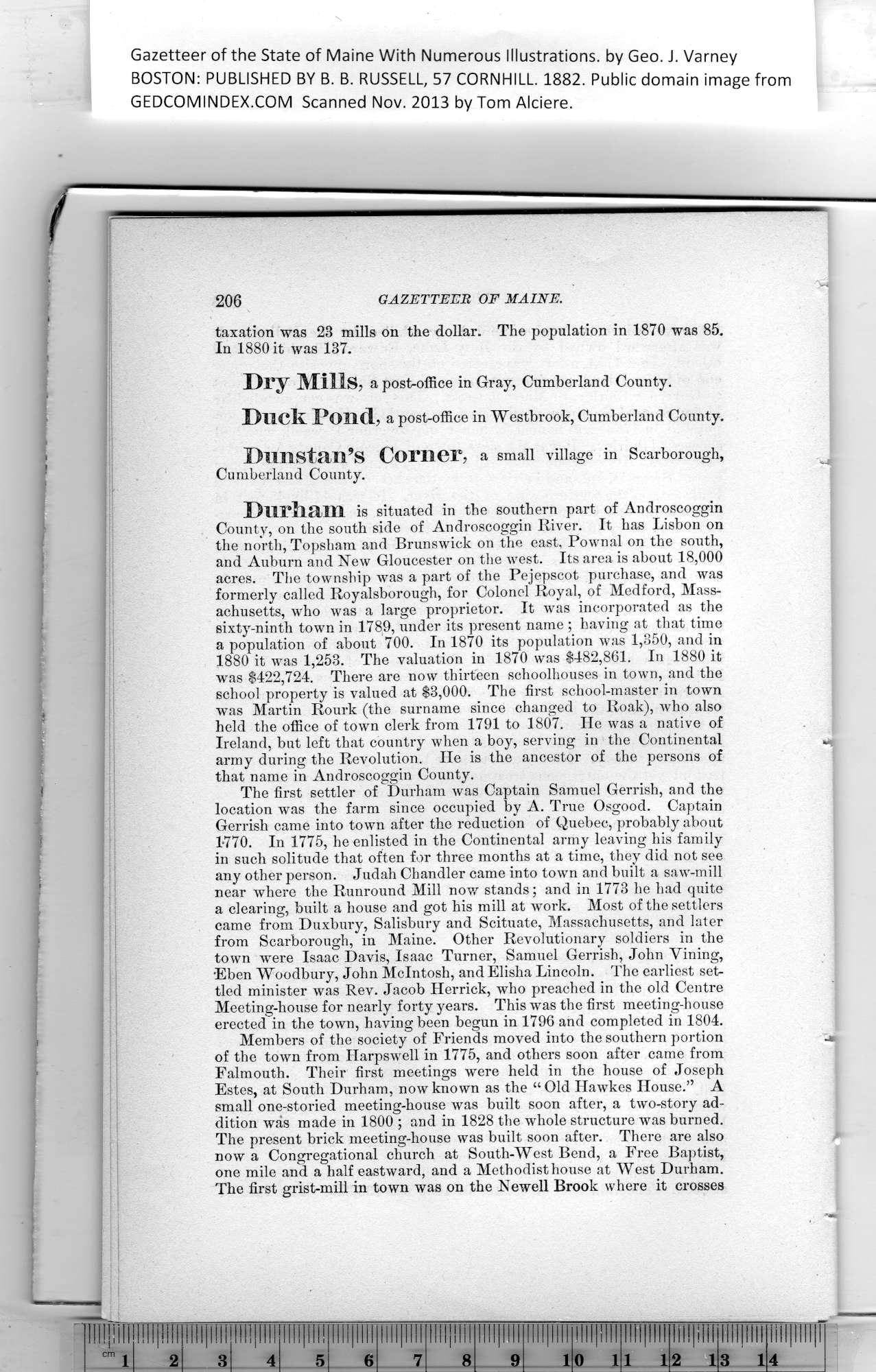|
Gazetteer of the State of Maine With Numerous Illustrations, by Geo. J. Varney
BOSTON: PUBLISHED BY B. B. RUSSELL, 57 CORNHILL. 1882. Public domain image from
206 GAZETTEER OF MAINE.
taxation was 23 mills on the dollar. The population in 1870 was 85.
In 1880 it was 137.
Dry Mills, a post-office in Gray, Cumberland County.
DlICK Pond, a post-office in Westbrook, Cumberland County.
Dimstan’s Corner, a small village in Scarborough,
Cumberland County.
Durham is situated in the southern part of Androscoggin
County, on the south side of Androscoggin River. It has Lisbon on
the north, Topsham and Brunswick on the east, Pownal on the south,
and Auburn and New Gloucester on the west. Its area is about 18,000
acres. The towmship was a part of the Pejepscot purchase, and was
formerly called Royalsborough, for Colonel Royal, of Medford, Mass-
achusetts, who was a large proprietor. It was incorporated as the
sixty-ninth town in 1789, under its present name ; having at that time
a population of about 700. In 1870 its population was 1,350, and in
1880 it was 1,253. The valuation in 1870 was $482,861. In 1880 it
was $422,724. There are now thirteen schoolhouses in town, and the
school property is valued at $3,000. The first school-master in town
was Martin Rourk (the surname since changed to Roak), who also
held the office of town clerk from 1791 to 1807. He was a native of
Ireland, but left that country when a boy, serving in the Continental
army during the Revolution. He is the ancestor of the persons of
that name in Androscoggin County.
The first settler of Durham was Captain Samuel Gerrish, and the
location was the farm since occupied by A. True Osgood. Captain
Gerrish came into town after the reduction of Quebec, probably about
1*770. In 1775, he enlisted in the Continental army leaving his family
in such solitude that often for three months at a time, they did not see
any other person. Judah Chandler came into town and built a saw-mill
near where the Runround Mill now stands; and in 1773 he had quite
a clearing, built a house and got his mill at work. Most of the settlers
came from Duxbury, Salisbury and Scituate, Massachusetts, and later
from Scarborough, in Maine. Other Revolutionary soldiers in the
town were Isaac Davis, Isaac Turner, Samuel Gerrish, John Vining,
•Eben Woodbury, John McIntosh, and Elisha Lincoln. The earliest set-
tled minister was Rev. Jacob Herrick, who preached in the old Centre
Meeting-house for nearly forty years. This was tbe first meeting-house
erected in the town, having been begun in 1796 and completed in 1804.
Members of the society of Friends moved into the southern portion
of the town from Harpswrell in 1775, and others soon after came from
Falmouth. Their first meetings were held in the house of Joseph
Estes, at South Durham, now known as the “Old Hawkes House.” A
small one-storied meeting-house was built soon after, a two-story ad-
dition was made in 1800 ; and in 1828 the whole structure wras burned.
The present brick meeting-house was built soon after. There are also
now a Congregational church at South-West Bend, a Free Baptist,
one mile and a half eastward, and a Methodist house at West Durham.
The first grist-mill in town was on the Newell Brook where it crosses
PREVIOUS PAGE ... NEXT PAGE
This page was written in HTML using a program written in Python 3.2
|
